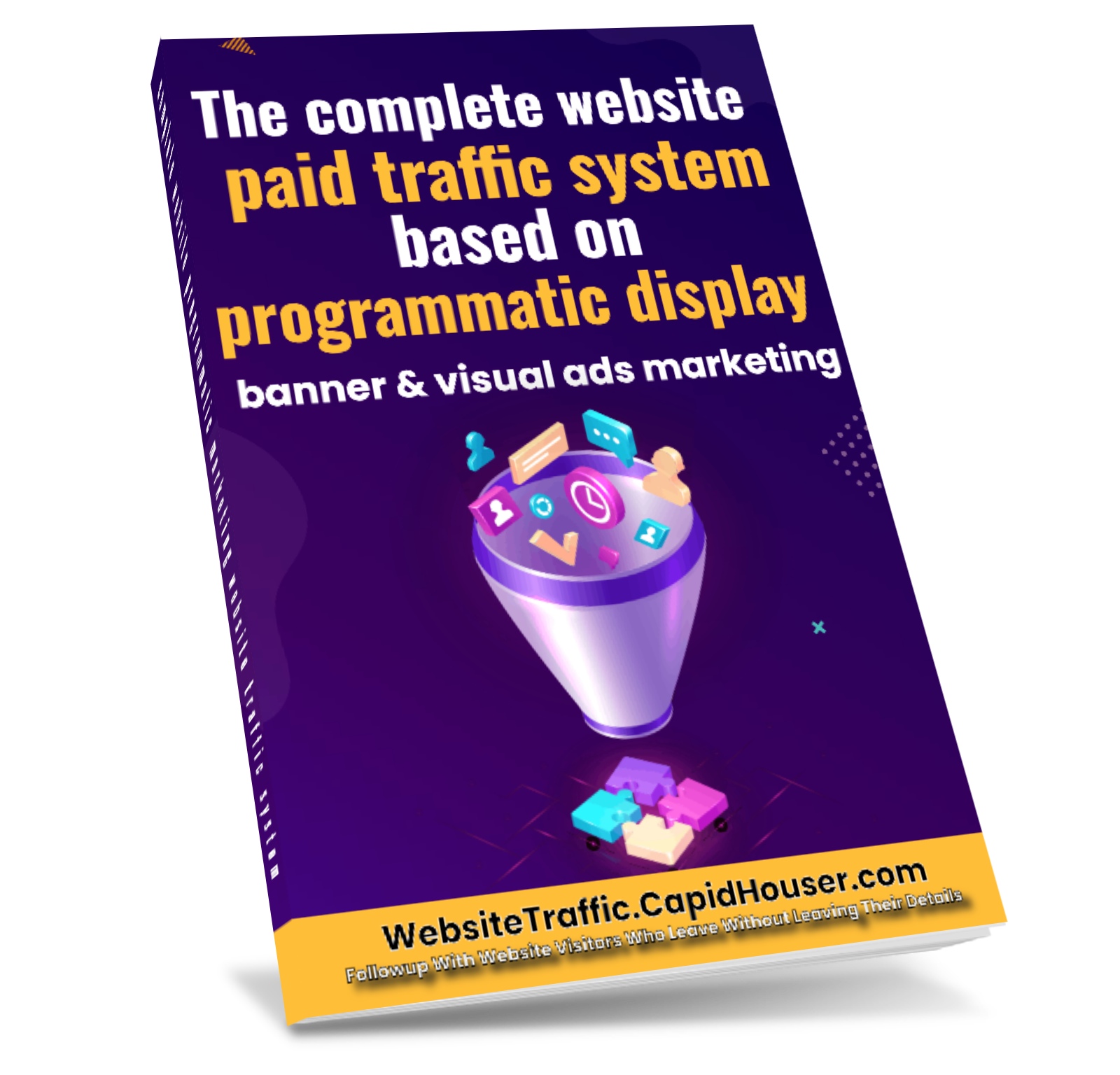Did you know marketers waste 26% of their budgets on inefficient programmatic advertising? If programmatic marketing display ads have been causing headaches, confusion, or disappointing returns, you are not alone. This comprehensive guide dives deep into the science and strategy of digital ad excellence, equipping you with the actionable expertise to transform underperforming campaigns into high-impact brand assets. Unlock the hidden power behind data-driven display advertising and make every pound count in your next campaign.
Unlocking the Power of Programmatic Marketing Display Ads for Modern Brands
In today's fast-paced digital advertising world, programmatic marketing display ads have emerged as one of the most powerful tools for brands striving to connect with the right audience at the right time. Brands are no longer bound by manual ad buying processes. Instead, they can now leverage automated technology to reach their target audience with precision and efficiency. This shift is revolutionising how display ads are bought and sold, making these campaigns more accessible and measurable for businesses of all sizes.
Despite this promise, many companies struggle to realise the true potential of programmatic ads . Common challenges include misunderstanding the nuances of ad exchange platforms, reliance on outdated banner ads and creative, as well as failing to optimise bids across display ad inventory. However, when executed correctly, programmatic marketing display ads empower brands to deliver personalised experiences, drive measurable ROI, and outpace the competition by leveraging real-time targeting and analytics. By understanding the ecosystem, recognising pitfalls, and applying advanced tactics, any marketer can unlock value that drives sustained growth for their brand.
Why Most Businesses Underperform with Programmatic Marketing Display Ads
It's all too common for brands to invest in digital ad technology only to face underwhelming results. The primary reason is a lack of understanding regarding how programmatic ads function and deliver value. Many businesses adopt programmatic strategies without fully tapping into the available data, resulting in misaligned targeting, wasted impressions, and subpar engagement. In addition, improper use of ad exchanges and ignoring advanced techniques (like header bidding ) actively limits campaign effectiveness.
"Marketers waste 26% of their budgets on inefficient programmatic advertising – let’s fix that."
The eagerness to automate often results in bypassing critical optimisation steps, such as creative refreshes, data segmentation, and real-time analytics. Consequently, these businesses fail to see the competitive advantage offered by modern programmatic advertising . Addressing these gaps is imperative for marketers seeking to move from programmatic mediocrity to a state of true digital advertising excellence.
Key Takeaways: Mastery of Programmatic Marketing Display Ads
Understand the fundamentals of programmatic advertising and display ad technology
Identify common mistakes in display ads strategy
Learn data-driven methods to amplify display advertising ROI
Apply actionable tactics for optimising programmatic ad performance
Programmatic Marketing Display Ads Explained: The Essentials
Before mastering programmatic marketing display ads, understanding their fundamental structure is essential. Unlike traditional banner ads that involve laborious ad buying negotiations and guesswork, programmatic ads use automation and advanced data algorithms to buy and place your ads. This means both small businesses and large brands can leverage display advertising to efficiently reach massive audiences across the digital ecosystem. At the heart of the system are sophisticated platforms like ad exchanges and side platforms , which enable programmatic ad placements to be bought and sold in real-time across thousands of websites and apps.
Whether your target audience is browsing news sites, watching a video ad on social media, or exploring industry blogs, programmatic marketing display ads ensure that your message appears at precisely the right time. This automated process is not just more efficient – it is also highly measurable, enabling marketers to optimise display campaigns in real-time and scale their results quickly. As we explore further, you'll see how the interplay between data, creative, and platforms can dramatically impact your campaign's bottom line.
For a deeper dive into the practical steps and digital marketing strategy development that underpin successful programmatic display campaigns, you may find it helpful to explore this guide on building a robust programmatic marketing display ads strategy . It offers actionable insights that complement the foundational concepts discussed here.
Introduction to Display Ad Technology and Programmatic Advertising
At its core, programmatic advertising refers to the automated process of buying and selling digital ad inventory through technology platforms. This typically involves the use of real-time bidding ( RTB ), in which software selects and places ads for users on the basis of highly specific data signals. For the average marketer, this means eliminating much of the guesswork historically involved in ad campaigns. Instead of hoping your banner ads appear in the right places, programmatic technology ensures your display ads target the right audience at the most opportune moment.
With a blend of algorithms, ad exchanges , and side platforms , programmatic solutions transform online advertising into a science. Major platforms offer extensive targeting features, from demographic and interest-based segmentation to retargeting site visitors and managing frequency. By integrating these tools into your digital ad strategy, you can buy ad space across multiple channels – including mobile, social, display, and even connected TV – with unprecedented agility. This holistic approach allows for effective cross-channel management and enhances your brand’s ability to drive conversions.

How Programmatic Ads Are Bought and Sold Through Ad Exchanges
In the programmatic advertising ecosystem, ad exchanges play a crucial role as the marketplace where digital ad inventory is bought and sold. These exchanges facilitate real-time bidding between advertisers and publishers, allowing for near-instantaneous transactions that are governed by algorithms. Advertisers use demand-side platforms (DSPs) to target specific audiences and organise their purchases, while publishers offer their ad space via supply-side platforms (SSPs). The result is an ultra-efficient, competitive marketplace that matches your programmatic marketing display ads to your ideal customers in a fraction of a second.
The use of header bidding further increases inventory value by letting publishers offer their ad space to multiple ad exchanges at the same time, driving up competition (and revenues). This strategy ensures that each impression is sold at the best possible price, while giving advertisers more opportunities to reach their target audience. Whether it’s a banner ad on a niche website or a video ad on a major streaming service, understanding how your ads are bought and sold will give you the upper hand in achieving your marketing strategy goals.
Term |
Definition |
Example/Use Case |
|---|---|---|
Programmatic Ad |
Automated ad buying using software and data algorithms |
Real-time bidding on digital ad platforms |
Display Ad |
Visual-based ad units across websites and apps |
Banner ad on a news site |
Ad Exchange |
Digital marketplace for ad buying and selling |
Google AdX, OpenX |
Header Bidding |
Advanced programmatic technique to improve ad inventory value |
Deploying header bidding on multiple ad networks |
How Programmatic Marketing Display Ads Revolutionise Digital Advertising
The rise of programmatic advertising has fundamentally changed the landscape of digital marketing. Rather than making broad assumptions about your target audience, programmatic technology harnesses data-driven insights to serve display ads with pinpoint accuracy. This approach means that each impression is tailored to a user’s behaviour, location, interests, and even the time of day, maximising the chance of engagement and conversion. The flexible architecture of ad exchanges , coupled with automation, has democratised outreach, making sophisticated campaigns accessible to businesses of all sizes.
For brands aiming to stay ahead in digital advertising , leveraging programmatic marketing display ads is no longer optional. The technology empowers organisations to test, iterate, and optimise in real-time, ensuring that wasted impressions and budget are kept to a minimum. Moreover, innovations like dynamic creative optimisation and smart bidding further elevate results, allowing for personalised messages delivered at scale. It's not just about reaching more people, but about reaching the right people, at the right time, with the right creative – all through a seamless, automated process.

The Role of Data in Programmatic Advertising for Display Ads
Data sits at the core of effective programmatic advertising , powering every decision from audience targeting to bid adjustments. Sophisticated algorithms analyse vast amounts of first-party and third-party data, such as demographic profiles, online behaviour, browsing patterns, and even live geolocation. This information guides how display ads are served, maximising relevance and minimising waste. The ability to use programmatic data in real-time means marketers can proactively adapt campaigns—shifting budget, testing creative, or honing audience segments—on the fly.
Through correlations and trends, you can identify high-value prospects and boost campaign ROI. For example, data might reveal that a specific side platform delivers better engagement for video ad placements, prompting you to invest more heavily in that channel. Advanced analytics also allow precise post-campaign evaluation, revealing which aspects of your display advertising are most impactful and where optimisations are needed. The end result? Every ad placement is engineered to convert, supported by a closed loop of continuous learning.

Why Display Advertising Automation Matters for Growth
As digital ecosystems become increasingly complex, manual ad buying simply can't keep pace with the demands for scale, speed, and personalisation. Display advertising automation enables brands to handle campaign management, audience segmentation, and ad creative delivery with unmatched efficiency. This automation ensures ads appear in premium locations when your audience is most receptive, multiplying your chance for meaningful engagement. Moreover, programmatic marketing display ads free up your marketing team to focus on high-value strategy and creative innovation rather than repetitive administrative tasks.
Businesses that embrace automation are consistently rewarded with greater agility, improved tracking, and superior outcomes. Programmatic approaches not only increase campaign reach across multiple channels, including mobile, desktop, and social media , but also tighten control over budgets and performance metrics. In this way, automation in display advertising isn't just a trend – it's a foundational pillar for brands aiming to achieve growth, scalability, and competitive advantage.
Common Pitfalls: Where Programmatic Marketing Display Ads Fail
Relying on incomplete customer data for digital ad targeting: Without a robust data strategy, targeting can become broad and ineffective, leading to wasted impressions and poor ROI.
Misunderstanding how display ads are bought and sold: Failing to grasp the mechanics of ad exchanges and programmatic ad auctions often leads to strategic missteps and unnecessary spending.
Underutilising ad exchange and header bidding opportunities: Not leveraging these advanced tools can result in missing out on valuable ad inventory and higher-value placements.
Neglecting ad creative optimisation in programmatic ads: Sticking to static, uninspired creatives limits engagement and undermines the personalisation potential of programmatic display ad campaigns.

Essential Components of High-Performing Programmatic Marketing Display Ads
To win in the crowded digital advertising landscape, your programmatic marketing display ads must be built on a solid foundation. This means going beyond generic banners or catch-all messaging. Success starts with understanding your target audience and curating ads that speak to their interests, needs, and pain points. Equally important is leveraging the latest technology—optimising your creative assets, harnessing dynamic bidding, and analysing results through top-tier reporting platforms.
Effective campaigns integrate a multi-layered strategy: sharp ad creative, programmatic targeting, optimised placements using header bidding, and constant refinement. By embracing a data-driven, iterative approach, you can enhance ad relevance, boost engagement, and ultimately, achieve better conversion rates. The following sections break down these must-have elements for high-performing programmatic marketing display ads.
The Anatomy of Effective Digital Ad Creatives
The difference between overlooked banner ads and high-converting display ads is the quality of creative execution. Effective digital ad creatives blend compelling visuals, actionable messaging, and a clear value proposition, all perfectly tailored to the target audience. The combination of crisp graphics, concise copy, and an irresistible call-to-action compels viewers not just to notice your brand, but to engage.
With programmatic technology, your creative assets must adapt to a variety of formats and placements—across websites, mobile apps, and social media. Leveraging dynamic elements such as location-based messaging or real-time offers ensures that every impression feels hyper-relevant to the user. Regular A/B testing and creative refreshes guarantee that ads remain impactful and prevent creative fatigue, thereby maximising your ROI in digital advertising.

Leveraging Ad Exchanges and Side Platforms for Maximum Impact
Ad exchanges are the beating heart of programmatic advertising, providing a marketplace for advertisers and publishers to transact instantly. Brands can access vast ad inventory across thousands of publishers, ensuring robust campaign reach for their display ads . Using multiple ad exchanges – and integrating side platforms for specialised placements – allows marketers to diversify delivery, manage costs effectively, and reduce the risk of over-reliance on a single network.
Side platforms can deliver niche targeting, additional data integrations, or exclusive inventory not accessible through major ad exchanges alone. By combining both, savvy marketers drive broader exposure and more precise alignment with their target audience. An optimal multi-platform strategy encompasses real-time monitoring, fraud detection, and continuous optimisation, creating a seamless digital ad ecosystem that amplifies campaign outcomes.
Optimising Header Bidding and Ad Placement
Header bidding is a game-changer for publishers and advertisers alike. This advanced programmatic technique allows multiple demand sources to compete for each display ad impression, unlocking higher revenues for publishers and better opportunities for brands. As a marketer, mastering header bidding means you can access premium ad inventory and secure prime placements for your programmatic marketing display ads .
Optimising ad placement goes hand-in-hand with header bidding. Strategic use of audience data ensures your ads appear not just in high-traffic locations, but in contextually relevant environments where engagement is likely highest. Real-time analytics enable you to adjust bids, test new placements, and monitor for ad fraud or performance issues – all crucial for delivering sustained success in digital advertising campaigns.
A Step-by-Step Guide to Launching Programmatic Marketing Display Ads Campaigns
Launching a successful programmatic marketing display ads campaign is a multi-stage process, requiring deliberate planning and execution. The steps below provide a blueprint for building campaigns that deliver genuine results—from targeting and creative development to integration and real-time optimisation.
By following each step methodically, you can systematically improve your brand’s exposure, learn from campaign analytics, and gradually refine your digital advertising approach for maximum growth.
Defining Precise Audience Segments in Programmatic Advertising
Effective segmentation lies at the heart of impactful programmatic advertising. Begin by identifying key characteristics of your ideal customers—demographic data, interests, online behaviour, location, and device usage. When you define your target audience in granular terms, your display ads are more likely to resonate and convert. Advanced solutions can also utilise intent signals and purchase history to reach prospects poised to take action.
Use programmatic tools to automatically adapt segments in real-time as new data becomes available. With precise segmentation, you minimise wasted ad impressions and maximise relevancy, making every marketing pound count. For best results, combine first-party (your own) data with third-party sources for deeper insights and competitive targeting.
Selecting and Integrating Side Platforms for Better Reach
Side platforms—such as demand-side platforms (DSPs) and data management platforms (DMPs)—are essential for achieving superior programmatic reach. They offer access to exclusive audience pools, unique data targeting, and advanced integrations that boost campaign performance. When selecting side platforms, consider their compatibility with your primary ad exchanges and your ability to manage cross-channel campaigns.
Integration is key. Leverage APIs, reporting tools, and unified dashboards to gain a 360-degree view of performance and make data-backed decisions. Brands that use multiple side platforms often see increased ad efficiency and greater penetration in competitive markets, as they’re able to reach niche users that may otherwise be inaccessible.

Running A/B Tests on Programmatic Ads
Continuous improvement in programmatic marketing display ads requires regular A/B testing. This process involves comparing multiple versions of your ad creative, copy, targeting, or landing pages to identify which combination produces the highest performance. With programmatic technology, these tests can be automated and scaled, allowing marketers to learn rapidly from real-world data.
Successful A/B testing focuses on variables like image selection, colour schemes, call-to-action wording, and even creative formats (such as dynamic versus static banner ads). Use side platforms and ad exchanges to split-test across various inventory sources, refining your approach with each campaign iteration. The lesson? Never settle for “good enough” – always push your campaigns towards optimal engagement and conversions.
Evaluating Results Using Digital Ad Analytics
No programmatic campaign is complete without robust analytics. Digital ad analytics tools deliver detailed insights into impressions, clicks, conversions, cost per action (CPA), and return on ad spend (ROAS). Monitor real-time results for each ad exchange, network, and side platform to identify what’s working—and, more importantly, what’s not.
Tracking key performance indicators (KPIs) helps you make quick, informed decisions about budget allocation, bid adjustments, and creative changes. Use advanced attribution models to understand the customer journey, from first impression to final conversion, and layer in fraud detection to ensure your spend is protected. With actionable analytics, you can fine-tune each component of your programmatic marketing display ads strategy.
Advanced Tactics to Supercharge Programmatic Marketing Display Ads
Once you’ve established a baseline, advanced tactics will catapult your programmatic marketing display ads to the next level. Adopting cutting-edge practices such as dynamic creative optimisation, smart bidding, and cross-channel execution ensures continuous growth and stays ahead of the ever-evolving digital landscape. High-performing marketers regularly test these advanced concepts, continually evolving their strategies for sustainable results and higher ROI.
Dynamic Creative Optimisation for Programmatic Ads
Dynamic creative optimisation (DCO) personalises display ads at scale by automatically generating ad variations based on audience data and contextual factors. This technology enables advertisers to serve the most relevant creative to each impression—adjusting everything from imagery to messaging in real time. The result: increased engagement rates, higher conversions, and more effective use of creative assets.
With DCO, you can target users based on their browsing behaviours, geographical location, device type, or purchase history, crafting bespoke experiences that feel organic and highly tailored. Integrating DCO into your programmatic marketing display ads approach ensures that even massive campaigns retain a personal touch.

Smart Bidding Strategies in Display Advertising
Bidding strategies have a direct impact on the effectiveness and efficiency of your programmatic campaign. Smart bidding uses machine learning algorithms to dynamically adjust your bids in real-time, aiming to achieve specific goals such as CPA, ROAS, or maximum reach. This automated approach mitigates the risks of manual errors and helps you take advantage of fleeting opportunities in the ad exchange .
To maximise returns, tailor your bidding strategy to each campaign objective and audience segment. Test automated bidding options (e.g., target CPA, enhanced CPC) across different networks and side platforms, closely monitor performance, and tweak as insights are gathered. The ability to outbid competitors for premium placements—while still maintaining efficiencies—delivers tangible gains for brands seeking to increase visibility and results.
Multi-Channel Approaches Using Ad Exchanges
Leveraging multiple channels expands your programmatic reach far beyond traditional websites. With the evolution of ad exchanges and side platforms, brands can run integrated campaigns across display, video, mobile apps, and even connected TVs. This approach ensures your message is visible wherever your target audience browses, consumes content, or shops.
Successful multi-channel campaigns require unified tracking and attribution, allowing you to compare performance across channels and allocate budgets dynamically. Utilise audience data to drive consistent messaging and synchronise creative assets for a cohesive brand experience—supercharging your results in the process.
"Winning with programmatic marketing display ads means treating every impression as a data opportunity."
People Also Ask About Programmatic Marketing Display Ads
What is a programmatic display ad?
A programmatic display ad is a visual advertisement, such as a banner or interactive graphic, that is purchased and placed through automated software on websites or apps. This process uses data algorithms and real-time bidding to ensure the right advertisement reaches the right audience at the right time, improving efficiency and campaign performance.
What is programmatic display advertising?
Programmatic display advertising is the use of automated technology to buy and serve visual-based ads across digital channels. It relies on data-driven platforms, ad exchanges, and algorithms to optimise ad placement, targeting, and budget allocation, making it faster, more precise, and often more cost-effective than traditional ad buying methods.
What's the difference between programmatic and display ads?
While display ads refer specifically to the visual format (such as banners or videos) shown across websites and apps, programmatic ads refer to any ad that is bought and placed via automated, data-driven technology. Programmatic display ads combine both concepts, using automation to deliver display ad formats to highly targeted audiences efficiently.
What are programmatic ads vs. display ads?
Programmatic ads are purchased using advanced software and data, allowing for real-time optimisation and targeting. Display ads , on the other hand, are the visual formats shown to consumers—such as banners, squares, or videos. Programmatic display ads incorporate both: digital ad creatives delivered and optimised via automated platforms for maximum effectiveness.
Proven Tips for Better Results from Programmatic Marketing Display Ads
Regularly refresh creative assets for higher engagement
Use lookalike audience segments in programmatic advertising
Apply frequency capping to manage digital ad fatigue
Monitor ad placements and side platforms for fraud
Frequently Asked Questions About Programmatic Marketing Display Ads
Are programmatic marketing display ads effective for small businesses?
Yes, programmatic marketing display ads can be highly effective for small businesses. They offer precise targeting, controlled budgeting, and access to audiences that were previously restricted to larger brands. By leveraging automation and analytics, small businesses can efficiently compete and scale their reach alongside much larger competitors.
How do side platforms and ad exchanges increase campaign reach?
Side platforms and ad exchanges expand campaign reach by providing access to a wider array of publishers, inventory, and exclusive audience segments. They enable brands to serve display ads across multiple networks, increasing visibility and diversifying where ads appear to target users wherever they spend time online.
What is the role of header bidding in programmatic advertising?
Header bidding is a strategy that allows publishers to offer their ad inventory to multiple ad exchanges simultaneously before making calls to their ad servers. This increases competition, maximises ad revenue opportunities for publishers, and provides advertisers with better placement and more premium ad inventory options for their programmatic display ads.
How can I measure success in display advertising campaigns?
Success in display advertising campaigns is measured by key performance indicators such as impressions, clicks, conversions, click-through rates (CTR), and return on ad spend (ROAS). Using advanced analytics, you can track the customer journey from exposure to conversion, identify the best-performing ad exchanges and creatives, and continually refine your approach for the highest return.
Elevate Your Brand with Expert Programmatic Marketing Display Ads Strategy
Take action now – contact us at https://www.capidhouser.com/paid-website-traffic/ to discuss your Display Ads Marketing Strategy. Unlock tailored guidance and discover proven tactics to energise your brand’s visibility with programmatic marketing display ads.
Ready to boost your results? Refine your approach, test aggressively, and focus on continual data-driven optimisation for programmatic marketing display ads that truly perform.
If you’re eager to expand your expertise beyond display ads and want to see how programmatic strategies are evolving with the latest advancements in AI, don’t miss the opportunity to explore how artificial intelligence is transforming programmatic marketing . Discover how AI-driven insights and automation are shaping the future of digital advertising, offering new ways to optimise campaigns and unlock even greater ROI. By staying ahead of these trends, you’ll be well-positioned to lead your brand into the next era of marketing innovation. Take your learning further and see what’s possible when you combine data, creativity, and cutting-edge technology.
To enhance your understanding of programmatic marketing display ads, consider exploring the following resources:
“The Ultimate Guide to Programmatic Display Advertising” ( invigomedia.com )
This comprehensive guide delves into the efficiency, precision targeting, and cost-effectiveness of programmatic advertising, providing actionable insights to optimize your campaigns.
“Programmatic Display and What You Need to Know About Modern Advertising Strategies” ( ipromote.com )
This article explores the benefits of programmatic display advertising, including real-time optimization and cross-device campaign strategies, offering practical advice to enhance your advertising efforts.
By reviewing these resources, you’ll gain valuable perspectives and strategies to refine your approach to programmatic marketing display ads.
 Add Row
Add Row  Add
Add 




Write A Comment